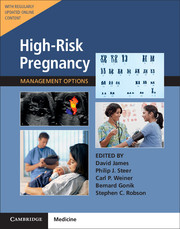Book contents
- Frontmatter
- Contents
- List of Contributors
- Preface
- Section 1 Prepregnancy Problems
- Section 2 Early Prenatal Problems
- Section 3 Late Prenatal – Fetal Problems
- Section 4 Problems Associated with Infection
- Section 5 Late Pregnancy – Maternal Problems
- Section 6 Late Prenatal – Obstetric Problems
- 52 Abdominal Pain in Pregnancy
- 53 Nonmalignant Gynecology in Pregnancy
- 54 Bleeding in Late Pregnancy
- 55 Multiple Pregnancy
- 56 Threatened and Actual Preterm Labor
- 57 Prelabor Rupture of the Membranes
- 58 Breech Presentation, Unstable Lie, Malpresentation, and Malpositions
- 59 Prolonged Pregnancy
- 60 Induction of Labor and Termination of the Previable Pregnancy
- 61 Dysfunctional Labor
- 62 Shoulder Dystocia
- 63 Fetal Compromise in Labor
- 64 Neuraxial Analgesia and Anesthesia in Obstetrics
- 65 Perineal Repair and Pelvic Floor Injury
- 66 Assisted Vaginal Delivery
- 67 Delivery After Previous Cesarean Section
- 68 Cesarean Section
- Section 7 Postnatal Problems
- Section 8 Normal Values
- Index
55 - Multiple Pregnancy
from Section 6 - Late Prenatal – Obstetric Problems
- Frontmatter
- Contents
- List of Contributors
- Preface
- Section 1 Prepregnancy Problems
- Section 2 Early Prenatal Problems
- Section 3 Late Prenatal – Fetal Problems
- Section 4 Problems Associated with Infection
- Section 5 Late Pregnancy – Maternal Problems
- Section 6 Late Prenatal – Obstetric Problems
- 52 Abdominal Pain in Pregnancy
- 53 Nonmalignant Gynecology in Pregnancy
- 54 Bleeding in Late Pregnancy
- 55 Multiple Pregnancy
- 56 Threatened and Actual Preterm Labor
- 57 Prelabor Rupture of the Membranes
- 58 Breech Presentation, Unstable Lie, Malpresentation, and Malpositions
- 59 Prolonged Pregnancy
- 60 Induction of Labor and Termination of the Previable Pregnancy
- 61 Dysfunctional Labor
- 62 Shoulder Dystocia
- 63 Fetal Compromise in Labor
- 64 Neuraxial Analgesia and Anesthesia in Obstetrics
- 65 Perineal Repair and Pelvic Floor Injury
- 66 Assisted Vaginal Delivery
- 67 Delivery After Previous Cesarean Section
- 68 Cesarean Section
- Section 7 Postnatal Problems
- Section 8 Normal Values
- Index
Summary
Introduction
Multiple pregnancy is not an uncommon occurrence, affecting 2–3% of births. Prevalence rates vary significantly: in England and Wales 15.6 per 1000 women in 2013 had a multiple pregnancy, whereas in the United States the twin rate alone was 33.5 per 1000 live births (triplet and higher-order births were 103.6 per 100,000 births) in 2015. In France, twin rates were 15.6 per 1000 in 2011; an 80% increase from the 1970s. Monozygotic (MZ) twin births remain at a constant rate globally, while dizygotic (DZ) births demonstrate significant variation. As such, live-birth twins range from 6 in 1000 in Asia, to approximately 10–20 in 1000 in Europe and the USA, to 40 in 1000 in Africa. While there is some effect of racial background on twinning rates, among the three largest racial groups in the United States, non-Hispanic white, non-Hispanic black, and Hispanic, twin birth rates are essentially no different.
Until recently, the incidence of multiple births was continually rising, reflecting the effects of increased maternal age, parity, and use of assisted reproductive technology (ART). In the US, increased uptake of ART accounted for approximately 18% of cases in 2002, and this has particularly affected the rates of DZ twinning in women aged 45 and over. Furthermore, in the UK the triplet rate more than quadrupled between 1970 and 1998 following the introduction of ovulation induction and multiple-embryo-transfer fertility therapies.
However, since 1998 triplet and higher-order multiple rates have fallen annually, most likely reflecting changes in ART practice. In England and Wales in 2013 only 187 women gave birth to triplets and 3 to quads and above (live and stillbirths inclusive). Conversely, twin births have continued to rise. Across Europe the timing and extent of the increase has varied; between 1975 and 2002 the twinning rate increased by 50% in England and Wales and by 90% in the Netherlands. Reassuringly there is now evidence to suggest this surge is stabilizing, mainly owing to a policy of single embryo transfer.
- Type
- Chapter
- Information
- High-Risk Pregnancy: Management OptionsFive-Year Institutional Subscription with Online Updates, pp. 1581 - 1623Publisher: Cambridge University PressFirst published in: 2017

